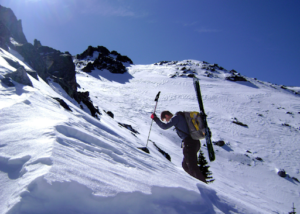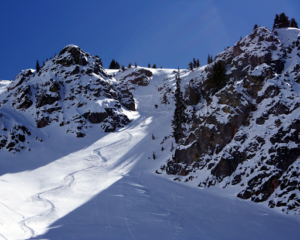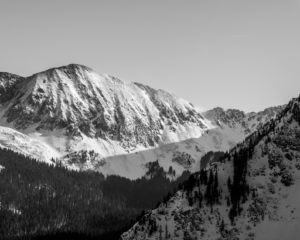Buy Taos and Santa Fe Guidebook
Being so far south in latitude and with nearly 300 sunny days a year, there’s a good chance you’ll be skiing in the sunshine in New Mexico. The snow here is unique because it is dry, cold, and powdery throughout the winter with great corn skiing in the spring. The snowpack also tends to be more consistent due to more minor temperature fluctuations than you are likely to see further north.
The Taos + Santa Fe guidebook can be divided into three geographical regions. The first is the Taos range that includes Wheeler Peak and the ski area there. The second region is the area around the Truchas Range, a lesser explored mountain. And lastly, Santa Fe and the mountain and sidecountry skiing there.
- Ascending
- Fresh turns, blue skies
- Historical Wheeler Peak photo
The skiing history in New Mexico is rich and dates back to the late 1800s and early 1900s with prospectors trying out their skis for both practical uses and for casual fun. New Mexico is also home to what is likely the oldest-known photo of a Native American on skis. The image from around 1900, shows a man from Taos Pueblo on skis in Hondo Valley (just a few miles from Taos Ski Valley), holding one long wooden pole in lieu of the preferred two short ski poles of today.
With the advent of backcountry skiing technology, access has exploded and NM offers vast opportunities for the enthusiastic adventurer. This guidebook serves as a primer for what all is out there. There are even several abandoned ski resorts that serve as good places to ski. Generally, there is good freedom for backcountry access, but Taos Ski Valley is the exception. They don’t let you venture from the resort boundaries to out of bound terrain during the season. But, fun tip, you can ski inbounds once the resort is closed for the season because it is national forest land. The Taos Ski Valley can be found to the northwest of Wheeler Peak.
Wheeler Peak (13,167’) is the highest peak in the state of New Mexico. In the 1870s, U.S. Army Major George Montague Wheeler began to make a topographic map of the southwestern United States, and this included New Mexico. After climbing the peak, he named it after himself. In fact, at least six mountains in the southwestern US are named after him. He was likely not the first to summit Wheeler Peak, but it is believed that the people of the Taos Pueblo had likely climbed it for many years before a white man came to stand on top.
In northern New Mexico lies a brilliant turquoise body of water known as Blue Lake, or Ba Whyea, which is a sacred land to the native Taos Pueblos. This is because it is believed that they were born from the waters of the lake. The settling of Taos began in 1200- 1250 A.D. and it has been a place of worship and spiritual significance since that time.
In 1906, the US Congress grabbed that land from the native people and made it part of a national forest. For 64 years, protesting ensued. These people fought to get their land back, and finally, in 1970, around 48,000 acres of land, including the Blue Lake, was returned to the pueblo. Hurray!
From the Wheeler Peak East Fork Bowl, on top of Simpson Peak, you can see Blue Lake. Admire it from afar but don’t ski off the south side of Simpson towards it; it is a sensitive area that deserves respect. For more information, look in our guidebook.
Truchas Range
Truchas Peak, in the Sangre de Cristo Mountains is a north-south running massif with four discernible summits, North Truchas Peak, Middle Truchas Peak, “Medio Truchas Peak”, and South Truchas Peak. South Truchas is the highest of the four and it is considered to be the second highest peak in the state of New Mexico at 13,108’. It is also the most southerly peak in the continental United States to rise higher than 13,000’.
Truchas Range is one of the biggest backcountry ski endeavors in New Mexico because of the unpredictability and intrinsic remoteness in every direction. Skiing in this zone should not be underestimated; it is a high commitment zone that takes serious planning and preparation. SAR is far away, there is no avalanche forecast, no ski patrol, no cell phone coverage, no paved roads, no huts. You’re out there, and you get to experience a very real sense of wilderness.
It’s a big adventure with massive payoff because of the overall reward of being in such a pristine, massive wilderness area. You likely won’t see anyone else out there or even their tracks; it is relatively untouched.
One of the first developed ski areas in NM came in the 1930s at Hyde Park near Santa Fe.
In 1949, the Sierras de Santa Fe group founded the Santa Fe Ski Basin and raised funds to build its first chairlift. The 50s and 60s saw huge changes and major developments for resort skiing in the region and it has only continued to grow in popularity since.
Ski Santa Fe is located in the Sangre de Cristo Mountains in northern New Mexico. It’s located in a beautiful alpine forest between 10,350’ (base) and 12,075’ (summit), which makes it one of the highest, and furthest south, ski resorts in the US.
Accessibility to Santa Fe is excellent during the winter season because you can take the lift at Ski Sante Fe to venture off into the backcountry and when you return, you can go back down through the resort. Check the Ski Santa Fe website for any updated rules and information. Backcountry skiing at Santa Fe is a bit more of a trek than in Taos, but not nearly as committing as the Truchas Range.
Whether you’re looking for an entirely remote destination like the Truchas Range, something full of other skiers like the Taos Range, or something in the middle like the Santa Fe Range, there’s a beautiful sunny slope waiting for you in New Mexico.



